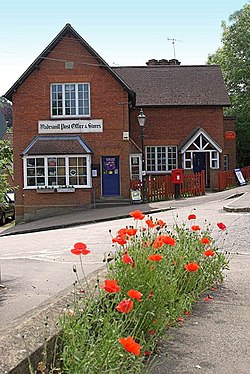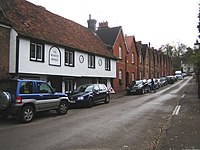Thundridge
| Thundridge | |
| Hertfordshire | |
|---|---|
 Thundridge's village shop | |
| Location | |
| Location: | 51°49’59"N, 0°-0’60"W |
| Data | |
| Population: | 475 |
| Postcode: | SG12 |
| Dialling code: | 01920 |
| Local Government | |
| Council: | East Hertfordshire |
| Parliamentary constituency: |
North East Hertfordshire |
Thundridge is a village in Hertfordshire about two miles away from the town of Ware and about seven miles away from the county town, Hertford. Nearby villages include Wadesmill and Tonwell, and the hamlets of Cold Christmas and High Cross.
Thundridge has a primary school, a church, a shop, a popular village hall and a pub. It also has a school playing field, allotments and football and cricket pitches.
The village stands on the route of the old Cambridge Road, which is from earlier ages the route of the Roman road known as Ermine Street. In the modern age this became the A10, until it was by-passed in 2005. Now Thundridge no longer has thundering traffic and has become a quiet village.
History
The village of Thundridge was originally located about half a mile to the east of the current Thundridge location, also adjacent to the River Rib. There are references to "Tonrich" in the Domesday Book with land being held by the Bishop of Bayeux and tenanted by Hugh de Grentmesnil, with the record indicating that there was a drop in the value of the land from 100 shillings to 40 shillings.[1][2] There had however been civilised habitation in the area earlier than that: both Roman and Saxon remains have been found in the adjacent estate known as "Youngsbury" just a few hundred yards away from the old Thundridge location.

In 1826 the London to Cambridge road (that runs on the west side of today's Thundridge) was improved. Formerly the road had run a more crooked path through "Ermine" or "Back Street" in the village. There was then an migration to a new location, adjacent to the new main road, and the original village lay abandoned and soon vanished moved. A new church was built in 1851 where the new Thundridge had grown 1851 and consecrated in 1854.
All that now remain of the old Thundridge are the 15th century church tower of the "Thundridge Old Church", which is to say All Hallows and Little Saint Mary, and a few bricks from the chimney stack of the Manorial home of Thundridgebury.
Thundridgebury was built during the reign of Henry VIII, possibly by Henry Gardiner - the Gardiners being a family that became prominent in later years giving name to the nearby wood "Gardiner's Spring". The last inhabitants of Thundridgebury were the Hollingsworth family, who had bought it from Daniel Giles, who had in turn purchased it from the Gardiners. The house was dismantled in the early 19th century, as was subsequently the church in 1854. Only the chimney stack of Thundridgebury and the tower of the church remained. According to local legend, the chimney stack was left standing in order to allow the owners to continue to collect rent, but a later research suggested that its presence allowed the owners to maintain a pew in the new Thundridge church, as technically the manorial land which had been absorbed into the Youngsbury estate when purchased by the Giles, now fell under the parish of Standon, whose church was some 5 miles distant. So long as the chimney stack remained however, the pew in the Thundridge church was kept available for the owners of the (now combined) property of Youngsbury.[1]
Outside links
- Thundridge village website
- Thundridge Village Hall website
- Thundridge Village School website
- Hertfordshire Genealogy website Thundridge Information
- Visitor UK website Thundridge Information
- Thundridge Old Church Historical Information